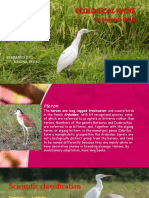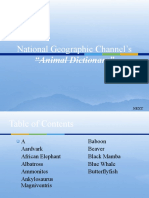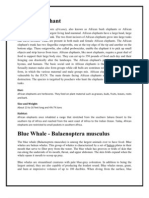Zebra
Zebra
Uploaded by
llorchscribdCopyright:
Available Formats
Zebra
Zebra
Uploaded by
llorchscribdCopyright
Available Formats
Share this document
Did you find this document useful?
Is this content inappropriate?
Copyright:
Available Formats
Zebra
Zebra
Uploaded by
llorchscribdCopyright:
Available Formats
Zebra
Scientific classification Kingdom: Animalia Phylum: Chordata Class: Mammalia Order: Perissodactyla Family: Equidae Genus:
Equus Subgenus: Hippotigris and Dolichohippus Species Equus zebra Equus quagga Equus grevyi
Zebras are African equids best known for their distinctive black and white stripes. Their stripes come in different patterns unique to each individual.
They are generally social animals and can be seen in small harems to large herds. In addition to their stripes, zebras have erect, mohawk-like manes.
Unlike their closest relatives, horses and asses, zebras have never been truly domesticated.There are three species of zebra: the plains zebra, Grévy's
zebra and the mountain zebra. The plains zebra and the mountain zebra belong to the subgenus Hippotigris, but Grevy's zebra is the sole species of
subgenus Dolichohippus. The latter resembles an ass, while the former two are more horse-like. Nevertheless, DNA and molecular data show that
zebras do indeed have monophyletic origins. All three belong to the genus Equus, along with other living equids. In certain regions of Kenya, plains
zebras and Grevy's zebras coexist.The unique stripes and behaviors of zebras make these among the animals most familiar to people. They can be
found in a variety of habitats, such as grasslands, savannas, woodlands, thorny scrublands, mountains and coastal hills. However, various
anthropogenic factors have had a severe impact on zebra populations, in particular hunting for skins and habitat destruction. Grevy's zebra and the
mountain zebra are endangered. While plains zebras are much more plentiful, one subspecies, the quagga, went extinct in the late nineteenth
century.
Condor
Scientific classification Kingdom: Animalia Phylum: Chordata Class: Aves Order: Ciconiiformes Family: Cathartidae Genera
Vultur Gymnogyps
Condor is the name for two species of New World vultures, each in a monotypic genus. They are the largest flying land birds in the Western
Hemisphere. They are:
The Andean Condor (Vultur gryphus) which inhabits the Andean mountains.
The California Condor (Gymnogyps californianus) currently restricted to western coastal mountains of the United States and Mexico.Condors are part
of the family Cathartidae, whereas the 15 species of Old World vultures are in the family Accipitridae, that also includes falcons, hawks, and eagles.
The New World and Old World vultures evolved from different ancestors. However, they both are carrion-eaters and have distinctive bare
heads.California Condor in high speed flight. Note tip feathers faired to reduce drag.
[edit]Appearance
Both condors are very large broad-winged soaring birds, the Andean Condor being 5 cm shorter (beak to tail) on average than the northern species,
but larger in wingspan. California Condors are the largest flying land birds in North America.
Whale shark
Scientific classification Kingdom: Animalia Phylum: Chordata Class: Chondrichthyes Subclass: Elasmobranchii Order:
Orectolobiformes Family: Rhincodontidae (Müller and Henle, 1839) Genus: Rhincodon Smith, 1829 Species: R. typus
Binomial name Rhincodon typus (Smith, 1828)
Range of whale shark
The whale shark, Rhincodon typus, is a slow-moving filter feeding shark, the largest living fish species. The largest confirmed individual was 12.65
metres (41.50 ft) in length. The heaviest weighed more than 36 tonnes (79,000 lb)[2], but unconfirmed claims report considerably larger whale
sharks. This distinctively-marked fish is the only member of its genus Rhincodon and its family, Rhincodontidae (called Rhinodontes before 1984),
which belongs to the subclass Elasmobranchii in the class Chondrichthyes. The shark is found in tropical and warm oceans, lives in the open sea with
a lifespan of about 70 years.[3] The species originated about 60 million years ago. Although whale sharks have very large mouths, they feed mainly,
though not exclusively, on plankton, microscopic plants and animals, although the BBC program Planet Earth filmed a whale shark feeding on a
school of small fish.[4]The species was distinguished in April 1828, following the harpooning of a 4.6-metre (15.1 ft) specimen in Table Bay, South
Africa. Andrew Smith, a military doctor associated with British troops stationed in Cape Town described it the following year.[5] He published a more
detailed description in 1849. The name "whale shark" comes from the fish's physiology; as large as a whale, it too is a filter feeder.
[edit]Distribution and habitat
The whale shark inhabits all tropic and warm-temperate seas. Primarily pelagic, seasonal feeding aggregations occur at several coastal sites such as
the southern and eastern parts of South Africa; Gladden Spit in Belize; Ningaloo Reef in Western Australia; Útila in Honduras; Donsol, Pasacao and
Batangas in the Philippines; off Isla Mujeres and Isla Holbox in Yucatan Mexico; Ujung Kulon National Park in Indonesia; Nosy Be in Madagascar Off
Tofo Reef near Inhambane in Mozambique, and the Tanzanian islands of Mafia, Pemba and Zanzibar. Although typically seen offshore, it has been
found closer to land, entering lagoons or coral atolls, and near the mouths of estuaries and rivers. Its range is generally restricted to about ±30°
latitude. It is capable of diving to depths of 700 metres (2,300 ft), and is migratory.[3]
[edit]Anatomy and appearance
As a filter feeder it has a capacious mouth which can be up to 1.5 metres (4.9 ft) wide and can contain between 300 and 350 rows of tiny teeth.[6] It
has five large pairs of gills. Two small eyes are located towards the front of the shark's wide, flat head. The body is mostly grey with a white belly;
three prominent ridges run along each side of the animal and the skin is marked with a "checkerboard" of pale yellow spots and stripes. These spots
are unique to each individual and are useful for counting populations. Its skin can be up to 10 centimetres (3.9 in) thick. The shark has a pair each of
dorsal fins and pectoral fins. Juveniles' tails have a larger upper than lower fin while the adult tail becomes semi-lunate (crescent-shaped). Spiracles
are just behind the eyes.
You might also like
- T800 PDFDocument1 pageT800 PDFwilmar_tovar_133% (3)
- Knowledge Collection Catalogue Jan20Document20 pagesKnowledge Collection Catalogue Jan201804199No ratings yet
- Vampire The Masquerade Encyclopedia Vampirica PDFDocument218 pagesVampire The Masquerade Encyclopedia Vampirica PDFMarco CriNo ratings yet
- Zx81 ManualDocument102 pagesZx81 Manualpopmilo2009No ratings yet
- The Warning - Messages From Jesus Christ 2010 To 2011Document89 pagesThe Warning - Messages From Jesus Christ 2010 To 2011Jon RutherfordNo ratings yet
- Bio 3202 Lab Exercise No. 10Document14 pagesBio 3202 Lab Exercise No. 10nicole john forroNo ratings yet
- Endangered AnimalsDocument4 pagesEndangered AnimalsAhmed MostafaNo ratings yet
- AnimalDocument22 pagesAnimalJudin BellNo ratings yet
- Wildlife Fact File - Animal Behavior - Pgs. 91-93Document6 pagesWildlife Fact File - Animal Behavior - Pgs. 91-93ClearMind84No ratings yet
- Reptiles: Snakes Lizards Crocodiles Turtles Tuatara VertebratesDocument10 pagesReptiles: Snakes Lizards Crocodiles Turtles Tuatara VertebratesJemarkTicmonMagpayoNo ratings yet
- Zoo102 - Mammalia MetatheriaDocument37 pagesZoo102 - Mammalia MetatheriaSushmita Zen BanaagNo ratings yet
- North American Porcupine Porc-Épic D'amérique Du Nord Puerco EspínDocument6 pagesNorth American Porcupine Porc-Épic D'amérique Du Nord Puerco EspínitsankurzNo ratings yet
- PerezDocument9 pagesPerezHeizyl ann VelascoNo ratings yet
- Kangaroo: Article Talk Read View Source View HistoryDocument7 pagesKangaroo: Article Talk Read View Source View Historywahyu nugrohoNo ratings yet
- Extinct AnimalsDocument8 pagesExtinct AnimalsmilakamilaNo ratings yet
- Horseshoe Crab: Limulidae Horseshoe Crabs Are Marine and Brackish Water Arthropods of TheDocument9 pagesHorseshoe Crab: Limulidae Horseshoe Crabs Are Marine and Brackish Water Arthropods of Theenzo abrahamNo ratings yet
- Presentor: Alyanna D. de Leon Beed-1EDocument36 pagesPresentor: Alyanna D. de Leon Beed-1EAly D. De LeonNo ratings yet
- Armadillos Are: Order CingulataDocument3 pagesArmadillos Are: Order CingulataAnirudh AgrawalNo ratings yet
- INTRODUCTION TO PERISSODACTYLA (Odd-Toed Ungulates) : Ungulates (Meaning Roughly "BeingDocument5 pagesINTRODUCTION TO PERISSODACTYLA (Odd-Toed Ungulates) : Ungulates (Meaning Roughly "BeingYusni AtifahNo ratings yet
- MammalsDocument4 pagesMammalscristhianmadrid1415No ratings yet
- Armadillo Meerkat NarwhalDocument16 pagesArmadillo Meerkat Narwhalganeshthangam.e3324No ratings yet
- Info of AlbumDocument3 pagesInfo of Albumabshek97No ratings yet
- National Geographic Channel'sDocument22 pagesNational Geographic Channel'smorrisbana0620No ratings yet
- Crocodile (Reptile) - EncartaDocument1 pageCrocodile (Reptile) - Encartaxxxbilly1986xxxNo ratings yet
- All About Extinct SpeciesDocument7 pagesAll About Extinct SpeciesjaackshaarmaaNo ratings yet
- Amphibians - Advanced: Amphibians Nature General Conference See Also Skill Level 1 Year of Introduction: 1945Document15 pagesAmphibians - Advanced: Amphibians Nature General Conference See Also Skill Level 1 Year of Introduction: 1945Jun Siguenza AmbrocioNo ratings yet
- ReptilesDocument36 pagesReptilesArabelle Da FirstNo ratings yet
- Vertebrate and InvertebratesDocument9 pagesVertebrate and InvertebratesgwenethzNo ratings yet
- Chapter 2 Snakes of Papua New GuineaDocument23 pagesChapter 2 Snakes of Papua New GuineaIrfan Haidar BasyirNo ratings yet
- 5 National BirdsDocument5 pages5 National BirdsAmrit TejaniNo ratings yet
- Biology 14Document7 pagesBiology 14Willian CarbajalNo ratings yet
- Tarta de CilosinaDocument15 pagesTarta de CilosinaSlim BunnieNo ratings yet
- Weird Birds BeaksDocument12 pagesWeird Birds BeaksLeonardo Molano DussanNo ratings yet
- Writing Unit: Non-Chronological ReportDocument23 pagesWriting Unit: Non-Chronological Reportanimedarkzone084No ratings yet
- Flagship Species in Pakistan bySYED ABDULLAH SHAHDocument4 pagesFlagship Species in Pakistan bySYED ABDULLAH SHAHZafar KhanNo ratings yet
- Essay On The Important Zoogeography Regions of Planet Earth!Document10 pagesEssay On The Important Zoogeography Regions of Planet Earth!Muhammad AhmadNo ratings yet
- Speculations On Dixon's New Dinosaurs: Classifying "The New Dinosaurs" For Spec WorldDocument15 pagesSpeculations On Dixon's New Dinosaurs: Classifying "The New Dinosaurs" For Spec WorldLauraHenson0% (1)
- Endangered SpeciesDocument35 pagesEndangered SpeciesEstefany RomeroNo ratings yet
- Fish 1Document129 pagesFish 1Bessie Jhoy GalimbaNo ratings yet
- DinoDocument4 pagesDinoJeremy EvansNo ratings yet
- Journal of Natural History Series 2: To Cite This Article: Alfred R. Wallace (1854) : On The Monkeys of The AmazonDocument6 pagesJournal of Natural History Series 2: To Cite This Article: Alfred R. Wallace (1854) : On The Monkeys of The AmazonJose Manuel Villasuso AguiñagaNo ratings yet
- AlbatrossDocument18 pagesAlbatrossjosh321No ratings yet
- 20-Endangered and Extinct AnimalsDocument31 pages20-Endangered and Extinct AnimalsAubreyNo ratings yet
- Pigeons and Doves Constitute The BirdDocument5 pagesPigeons and Doves Constitute The BirdJermaine Weiss100% (1)
- Benthos ReportDocument17 pagesBenthos ReportBrendon TaggNo ratings yet
- OTTERSDocument6 pagesOTTERSMiguel LleraNo ratings yet
- ProjectDocument5 pagesProjectAbid ShaikhNo ratings yet
- Frogs vs. Toads: CaeciliansDocument2 pagesFrogs vs. Toads: CaeciliansZonny Zivins PresentsNo ratings yet
- Scientific ClassificationDocument10 pagesScientific ClassificationJea oelNo ratings yet
- Virgil Lesane-Research PaperDocument7 pagesVirgil Lesane-Research PaperVirgil LesaneNo ratings yet
- Bovid PassageDocument6 pagesBovid Passagedfullstack5No ratings yet
- Faculty of Medical Scienses-: University 'Goce Delcev'' StipDocument8 pagesFaculty of Medical Scienses-: University 'Goce Delcev'' StipStojance IlievskiNo ratings yet
- Aardwolf: Jump To Navigation Jump To SearchDocument8 pagesAardwolf: Jump To Navigation Jump To SearchYeyen M. EvoraNo ratings yet
- Janitor FishDocument2 pagesJanitor FishXyprexia DependentNo ratings yet
- AfricanDocument8 pagesAfricanadityaputrevuNo ratings yet
- Arctic TernDocument3 pagesArctic TernSudhakar P M StriverNo ratings yet
- Biology 2004Document41 pagesBiology 2004SciOlympiad2345100% (2)
- GharialDocument6 pagesGharialkk2512845013No ratings yet
- Foudaili Middle School - Djelfa 2010/11: My Project On Extinct AnimalsDocument6 pagesFoudaili Middle School - Djelfa 2010/11: My Project On Extinct AnimalsFathFethiNo ratings yet
- Anura (: (Hide)Document4 pagesAnura (: (Hide)kbarn389No ratings yet
- Cebu FlowerpeckerDocument7 pagesCebu FlowerpeckerPushpendra KumarNo ratings yet
- Branchiopoda - WikipediaDocument35 pagesBranchiopoda - WikipediaabeeramaryammuhammadlatifNo ratings yet
- Fomc Minutes 20221102Document12 pagesFomc Minutes 20221102ZerohedgeNo ratings yet
- Evaluation of Organoleptic &in-Vitro Bioavailability Properties of Iron Fortified YogurtDocument7 pagesEvaluation of Organoleptic &in-Vitro Bioavailability Properties of Iron Fortified YogurtIJAR JOURNALNo ratings yet
- SUGAR REGULATORY ADMINISTRATION, v. TORMONDocument2 pagesSUGAR REGULATORY ADMINISTRATION, v. TORMONChilzia Rojas100% (3)
- Effect of Mixed Corrosion Inhibitors in Cooling Water SystemDocument12 pagesEffect of Mixed Corrosion Inhibitors in Cooling Water SysteminejattNo ratings yet
- 113 Interview Test Questions and How To AnswerDocument21 pages113 Interview Test Questions and How To Answerkinerja.uip3bsNo ratings yet
- Classification & Types of ComputersDocument10 pagesClassification & Types of ComputersMudasir Abbas PhulpotoNo ratings yet
- Datasheet rk42Document2 pagesDatasheet rk42DAVIDNo ratings yet
- Unit 4 - My NeighborhoodsDocument4 pagesUnit 4 - My Neighborhoodsnguyen ngaNo ratings yet
- Makalah Brain GYM International, BDocument17 pagesMakalah Brain GYM International, BAuliaRahmanNo ratings yet
- Lesson 3 Social LifeDocument9 pagesLesson 3 Social LifeMaribel FelicenNo ratings yet
- Corel DrawDocument9 pagesCorel DrawashishasitisNo ratings yet
- Presentasi Strategy KepemimpinanDocument11 pagesPresentasi Strategy KepemimpinanI'll ChamNo ratings yet
- Lydia Kamonya CVDocument6 pagesLydia Kamonya CVDallas CyberNo ratings yet
- Column DesignDocument25 pagesColumn DesignNikhil100% (1)
- The Cost of Doing Nothing A Report On Alabamas Crumbling County Infrastructure WebDocument78 pagesThe Cost of Doing Nothing A Report On Alabamas Crumbling County Infrastructure WebRickey StokesNo ratings yet
- Penerapan Media Puzzle Job Pada Materi Sumber Daya Alam Dan Jenis Pekerjaan Kelas Iv Tema 4 SDN Gayungan Ii SurabayaDocument5 pagesPenerapan Media Puzzle Job Pada Materi Sumber Daya Alam Dan Jenis Pekerjaan Kelas Iv Tema 4 SDN Gayungan Ii SurabayaWildanilsNo ratings yet
- FFH Incident SECTION CHAPTER 2Document3 pagesFFH Incident SECTION CHAPTER 2EllNo ratings yet
- Sanitary / Watersupply DrawingsDocument8 pagesSanitary / Watersupply Drawingssurendra bhattaNo ratings yet
- Pre - UndripDocument18 pagesPre - UndripDianne Rose AgliamNo ratings yet
- IBN KHALDUN THOUGHT A Review of Al-Muqad PDFDocument12 pagesIBN KHALDUN THOUGHT A Review of Al-Muqad PDFHasan RahmanNo ratings yet
- People VS CabigquezDocument5 pagesPeople VS CabigquezGillian Alexis ColegadoNo ratings yet
- Conference Paper Literature ReviewDocument5 pagesConference Paper Literature Reviewsgfdsvbnd100% (1)
- Historical Aspects of Aeromedical Transport and Aerospace Medicine - ReviewDocument8 pagesHistorical Aspects of Aeromedical Transport and Aerospace Medicine - ReviewMiller brandãoNo ratings yet
- Ssim - 2005Document689 pagesSsim - 2005Chaudhary Bilal100% (1)
- 1 PBDocument12 pages1 PBAbdallah GrimaNo ratings yet

























































































